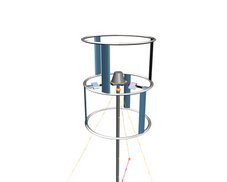Invariably, any investor discussion I have around Wind-Sail eventually touches on the subject of vertical axis competitors. In general, I have no problem trying to address and differentiate our product - that's when every entrepeneur should expect every time. Lately though, I seem to be encountering two sets of working assumptions that make this question a real trap:
Assumption #1: Investors that see VAWTs are junk, see them as having been written off by the leading experts, and the only people now presenting VAWTs are quacks, whacks, and nut jobs. Unfortunately, there is a ton of truth to this statement. The early history of first generation VAWTs should them to be substantially inferior to HAWTs and the market 'moved on' to HAWTs in significant ways and never looked back. Since then, the vast majority of VAWTs that show up are junk - they are based on faulty designs, weak structures, and make outrageous claims that are not back up technically.
Here are a few:
Let's put wind turbines along highways, because it's "windy" there. Sorry, but it's not. Yes, you can occaisionally experience wind gusts close to the edge of a road, but you can stand 5-10 feet from a highway with well provisioned, high speed traffic, and experience zero mile per hour winds. Also notice that the turbines would all be significantly displacing and disrupting each other. The general wind direction would be straight along the road, and you'd thus have to space these out considerable to avoid wind blocking.
Just out of curiousity on wind speeds need highways, I found this pic in google:
And I also found this transportation data on wind speeds. In here, you can see wind speed measurement data that averages out to a measly 8.5 km/hr which is a lousy 2.4 m/s. I'll writeup a post on the magnificant, magical power of cubes in wind speeds, but take it on faith for now that it's not worth your trouble, ever, to site wind turbines in such a weak wind regime. (would be like installing solar under a shady tree.)
The other nutter worthy of calling out is TMA Wind. Let's use wind "funnels" to focus the wind. Wind power is a function of blade rotation and torque. All wind systems that rely on "pushing" blades are limited to spinning only as fast as the wind blows, which converts to an upper CPP of 28% efficiency. Unless and until you can create drag on a blade, which can then accelerate the blade to spin faster than the wind (as all typical "horizontal" turbines operate, and spin upwards of 5-6x the wind), you are forever limited to really poor power efficiencies.
Another recent "drag" based design, Mariah Power, seems to have landed some angel investments. In defense of Mariah, they have some elements of lift in the blade designs, although any tubine that relies as heavily on drag as their blades do is probably still in the realm of 30-32% CPP on their design.
Yet, technology is not static, and the design, modelling tools for wind aerodynamics have not stayed still either. Using modern computer modelling and advanced 21rst century understandings of aerodynamics, VAWTs can achieve 40% + CPP - putting them "dead on" parity with CPP efficiencies for HAWTs.
The hard lesson here is:
You need healthy, vibrant, honest, capable competition, or else the investor community considers your entire space "tarnished." You really do face a doube-edged sword in competitive positioning a new technology startup. On the one hand, you need some viable, capable alternatives so that the water isn't muddied. On the other hand, you need to be legitimately different, better, and protective in your differentiation. A tough nut to crack appearently.
Thursday, March 15, 2007
The Competition As Double-Edge Swords
Posted by
Jeremy Stieglitz
at
12:31 PM
![]()
Labels: VAWT technology, Venture Investing in Wind
Subscribe to:
Comment Feed (RSS)




|